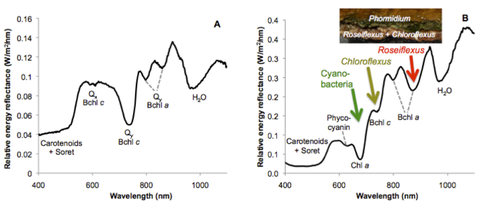2015 Annual Science Report
 VPL at University of Washington
Reporting | JAN 2015 – DEC 2015
VPL at University of Washington
Reporting | JAN 2015 – DEC 2015
Global Surface Biosignatures: Reflectance Spectra of Anoxygenic Phototrophs and Cyanobacteria
Project Summary
This project investigates the spectral reflectance signature of anoxygenic photosynthetic bacteria, as an alternative to the “biosignature” of the vegetation “red-edge.” The vegetation red-edge is so called due to the sharp contrast in visible light absorbance by light harvesting pigments in plant leaves versus their high reflectance in the near-infrared (NIR). This contrast occurs around 700 nm in the red/far-red. This signature is ubiquitous among plants, which all utilize chlorophyll a. However, anoxygenic phototrophs contain a diverse array primary photopigments, including bacterichlorophylls (Bchl) a, b, d, e, and g. These Bchl pigments display different absorption maxima with peaks primarily in the NIR. There is an abundance of data on plant spectral reflectance thanks to the Earth remote sensing field. However, there is a dearth of data on anoxygenic phototrophs and cyanobacteria. For this project, we measured the reflectance spectra of pure cultures as well as environmental samples of laminated microbial mats to characterize their detectable biosignature features. This work will help inform the search for life on exoplanets at a similar stage of evolution or biogeochemical state as the pre-oxic Earth.
Project Progress
We continued to perform experimental measurements of the reflectance spectra of anoxygenic phototrophs and cyanobacteria as global surface biosignatures. Our preliminary measurements showed that pure cultures of anoxygenic phototrophs produced “NIR edge(s)” in their spectral reflectance due to absorption of light by bacteriochlorophyll (Bchl) pigments. We assessed the detectability of these features in environmental samples of laminated microbial mats, and observed multiple NIR edges associated with each pigment. We initially expected only to detect the absorption of light by the pigments in the surface layer of the mat. Surprisingly, we detected cyanobacterial Chl a in the surface layer, as well as Bchl c and Bchl a in the anoxygenic underlayers (Fig. 1). This suggests that it does not matter “who’s on top,” as we were able to observe pigments through all mat layers due to their different absorption maxima. The presence of multiple pigments and thus multiple “NIR edges” could signify layered phototrophic communities and possibly strengthen support for the detection of surface exoplanet biosignatures (Parenteau et al., 2015 a,b). This work was presented at AbSciCon 2015 and at the 2015 meeting of the American Geophysical Union.
We also involved UW astrobiology graduate students in this work as part of their graduate training and they measured and analyzed reflectance spectra of Grand Prismatic hot spring in Yellowstone National Park
-
PROJECT INVESTIGATORS:
-
PROJECT MEMBERS:
Robert Blankenship
Co-Investigator
Tori Hoehler
Collaborator
Nancy Kiang
Collaborator
-
RELATED OBJECTIVES:
Objective 4.1
Earth's early biosphere.
Objective 5.2
Co-evolution of microbial communities
Objective 7.2
Biosignatures to be sought in nearby planetary systems


